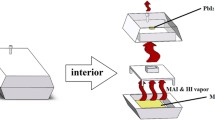Abstract
In this work, a high quality CH3NH3PbI3 thin film prepared by modified dual-source vapor evaporation was proposed. An ultra-thin PbI2 layer was deposited firstly, and then CH3NH3I and PbI2 were evaporated simultaneously to form CH3NH3PbI3 thin film. The results show that flat, uniform, smooth, less porous and good crystallinity perovskite thin films without impure phase are formed by the modified dual-source vapor evaporation. The ratios of Pb/I accord with the nominal MAPbI3 stoichiometry and the band gaps are about 1.60 eV close to the theoretical value of 1.55 eV. The properties of CH3NH3PbI3 thin film fabricated by this method are suitable for perovskite solar cells applications.








Similar content being viewed by others
References
A. Kojima, K. Teshima, Y. Shirai et al., Organometal halide perovskites as visible-light sensitizers for photovoltaic cells. J. Am. Chem. Soc. 131, 6050–6051 (2009)
N.J. Jeon, J.H. Noh, W.S. Yang et al., Compositional engineering of perovskite materials for high-performance solar cells. Nature 517, 476–480 (2015)
Q. Wang, H. Chen, G. Liu et al., Control of organic–inorganic halide perovskites in solid-state solar cells: a perspective. Sci. Bull. 60, 405–418 (2015)
D.B. Mitzi, Templating and structural engineering in organic–inorganic perovskites. J. Chem. Soc., Dalton Trans. 1, 1–12 (2001)
D. Shi, V. Adinolfi, R. Comin et al., Solar cells. Low trap-state density and long carrier diffusion in organolead trihalide perovskite single crystals. Science 347, 519–522 (2015)
Z. Xiao, Y. Yuan, Y. Shao et al., Giant switchable photovoltaic effect in organometal trihalide perovskite devices. Nat. Mater. 14, 193–198 (2015)
M. Xiao, F. Huang, W. Huang et al., A fast deposition-crystallization procedure for highly efficient lead iodide perovskite thin-film solar cells. Angew. Chem. 53, 9898–9903 (2014)
H. Zhou, Q. Chen, G. Li et al., Interface engineering of highly efficient perovskite solar cells. Science 345, 542–546 (2014)
J.H. Heo, S.H. Im, J.H. Noh et al., Efficient inorganic–organic hybrid heterojunction solar cells containing perovskite compound and polymeric hole conductors. Nat. Photonics 7, 486–491 (2013)
J. Burschka, N. Pellet, S.J. Moon et al., Sequential deposition as a route to high-performance perovskite-sensitized solar cells. Nature 499, 316–319 (2013)
G.E. Eperon, V.M. Burlakov, P. Docampo et al., Morphological control for high performance, solution-processed planar heterojunction perovskite solar cells. Adv. Funct. Mater. 24, 151–157 (2014)
A. Dualeh, N. Tétreault, T. Moehl et al., Effect of annealing temperature on film morphology of organic–inorganic hybrid pervoskite solid-state solar cells. Adv. Funct. Mater. 24, 3250–3258 (2014)
Q. Lin, A. Armin, R.C.R. Nagiri et al., Electro-optics of perovskite solar cells. Nat. Photonics 9, 106–112 (2014)
M. Liu, M.B. Johnston, H.J. Snaith, Efficient planar heterojunction perovskite solar cells by vapour deposition. Nature 501, 395–398 (2013)
L.K. Ono, S. Wang, Y. Kato et al., Fabrication of semi-transparent perovskite films with centimeter-scale superior uniformity by the hybrid deposition method. Energy Environ. Sci. 7, 3989–3993 (2014)
G.-X. Liang, P. Fan, J.-T. Luo et al., A promising unisource thermal evaporation forin situfabrication of organolead halide perovskite CH3NH3PbI3 thin film. Prog. Photovoltaics Res. Appl. 22, 1 (2015). doi:10.1002/pip.2632
A. Ng, Z.W. Ren, Q. Shen et al., Efficiency enhancement by defect engineering in perovskite photovoltaic cells prepared using evaporated PbI2/CH3NH3I multilayers. J. Mater. Chem. A 3, 9223–9231 (2015)
Q. Chen, H. Zhou, Z. Hong et al., Planar heterojunction perovskite solar cells via vapor-assisted solution process. J. Am. Chem. Soc. 136, 622–625 (2014)
Y. Zhao, K. Zhu, CH3NH3Cl-assisted one-step solution growth of CH3NH3PbI3: structure, charge-carrier dynamics, and photovoltaic properties of perovskite solar cells. J. Phys. Chem. C 118, 9412–9418 (2014)
H.B. Kim, H. Choi, J. Jeong et al., Mixed solvents for the optimization of morphology in solution-processed, inverted-type perovskite/fullerene hybrid solar cells. Nanoscale 6, 6679–6683 (2014)
J. He, L. Sun, Y. Chen et al., Influence of sulfurization pressure on Cu2ZnSnS4 thin films and solar cells prepared by sulfurization of metallic precursors. JPS 273, 600–607 (2015)
F. Huang, Y. Dkhissi, W. Huang et al., Gas-assisted preparation of lead iodide perovskite films consisting of a monolayer of single crystalline grains for high efficiency planar solar cells. Nano Energy 10, 10–18 (2014)
T. Baikie, Y. Fang, J.M. Kadro et al., Synthesis and crystal chemistry of the hybrid perovskite (CH3NH3)PbI3 for solid-state sensitised solar cell applications. J. Mater. Chem. A 1, 5628 (2013)
J. Shi, Y. Luo, H. Wei et al., Modified two-step deposition method for high-efficiency TiO2/CH3NH3PbI3 heterojunction solar cells. ACS Appl. Mater. Interfaces 6, 9711–9718 (2014)
J. Müller, J. Nowoczin, H. Schmitt, Composition, structure and optical properties of sputtered thin films of CuInSe2. Thin Solid Films 496, 364–370 (2006)
Acknowledgments
This work was supported by National Natural Science Foundation of China (Grant No. 61404086), Basical Research Program of Shenzhen (JCYJ20150324140036866), the special fund of the central finance for the development of local Universities (Grant No. 000022070150), the innovation development fund project of graduate student 2015 (Grant No. 0003600206).
Author information
Authors and Affiliations
Corresponding authors
Rights and permissions
About this article
Cite this article
Fan, P., Gu, D., Liang, Gx. et al. Growth of high quality CH3NH3PbI3 thin films prepared by modified dual-source vapor evaporation. J Mater Sci: Mater Electron 27, 2321–2327 (2016). https://doi.org/10.1007/s10854-015-4028-6
Received:
Accepted:
Published:
Issue Date:
DOI: https://doi.org/10.1007/s10854-015-4028-6




